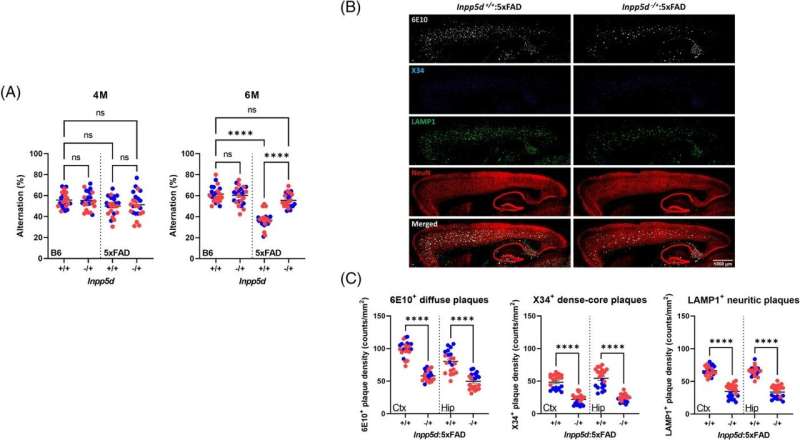Inpp5d haplodeficiency protects against cognitive impairment and amyloid beta (Aβ) accumulation in 5xFAD mice. (A) Working memory of 4- and 6-month-old male (blue) and female (red) animal cohorts assessed by percent of spontaneous alternation in the Y-maze task (n = 20–24 per genotype). Statistical analysis was performed by one-way analysis of variance (ANOVA) for spontaneous alternation followed by Tukey's post hoc test. Data are expressed as the mean ± SEM (ns, not significant and ****p < 0.0001). (B) Immunostaining of the diffuse plaques (6E10, gray), dense-core plaques (X34, blue), neuritic plaques (Lysosomal-associated membrane protein 1, LAMP1, green), and neurons (NeuN, red) in the brains of 7.5-month-old Inpp5d +/+:5xFAD and Inpp5d-/+:5xFAD mice. Scale bar, 1000 μm. (C) The density of plaques in the cortex and hippocampus was determined (n = 7 per genotype; male, blue; female, red). Statistical analysis was performed by Student's t-test for plaque density. Data are expressed as the mean ± SEM (****p < 0.0001). Credit: Alzheimer's & Dementia (2022). DOI: 10.1002/alz.12849
Indiana University School of Medicine researchers are studying how the reduction of a gene variant found in the brain's immune cells could diminish the risk of late-onset Alzheimer's disease.
The research team, led by Adrian Oblak, Ph.D., assistant professor of radiology and imaging sciences, and Peter Bor-Chian Lin, a Ph.D. candidate in the Medical Neuroscience Graduate Program at Stark Neurosciences Research Institute, recently published their findings in Alzheimer's & Dementia.
They focused their investigation on INPP5D, a microglia-specific gene that has been shown to increase the risk for developing late-onset Alzheimer's disease. Microglia are the brain's immune cells and there are multiple microglial genes associated with neurodegeneration.
Oblak said the team's previous data revealed that elevated levels of INPP5D in Alzheimer's disease lab models resulted in increased plaque deposition. Knowing this, they aimed to understand how reducing expression of INPP5D might regulate disease pathogenesis.
Using models in the lab, the researchers reduced the expression of the gene by at least 50%—called haplodeficiency—rather than completely knocking out the expression of the gene to mimic the treatment of pharmacological inhibitors targeting INPP5D as therapeutic strategies.
"INPP5D deficiency increases amyloid uptake and plaque engagement in microglia," Oblak said. "Furthermore, inhibiting the gene regulates microglial functions and mitigates amyloid pathology that are likely mediated by TREM2-SYK signaling pathway activation."
The gene deficiency also led to the preservation of cognitive function in the lab models. By reducing the expression of the gene in the brain, it created a less neurotoxic environment and improved the movement of microglia—which act as the first line of defense against viruses, toxic materials and damaged neurons—to clear amyloid deposits and plaques.
"These findings suggest that mitigating the function of INPP5D can result in a protective response by diminishing disease risk and mitigating the effect of amyloid beta induced pathogenesis," Lin said.
More information: Peter Bor‐Chian Lin et al, INPP5D deficiency attenuates amyloid pathology in a mouse model of Alzheimer's disease, Alzheimer's & Dementia (2022). DOI: 10.1002/alz.12849
Provided by Indiana University School of Medicine
























